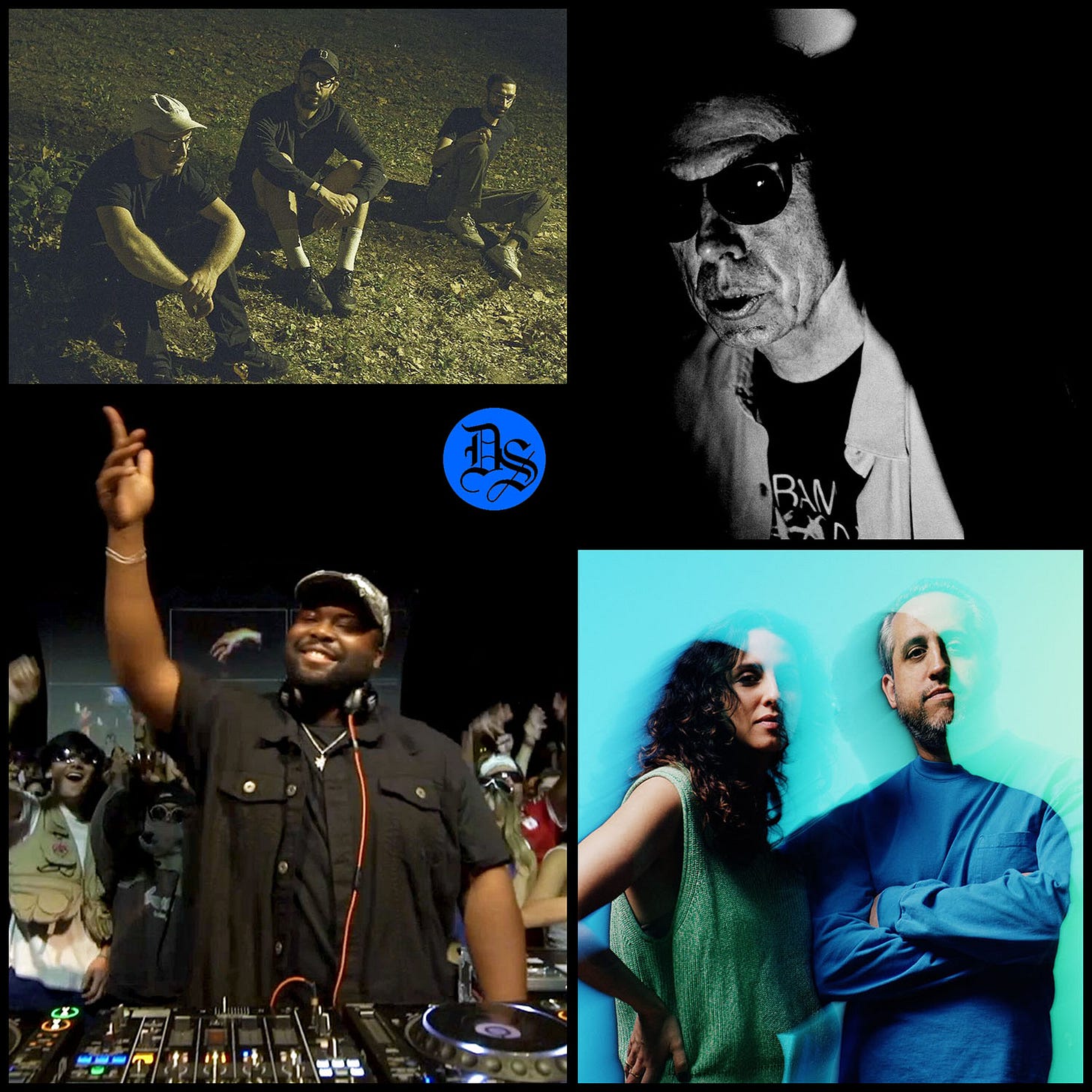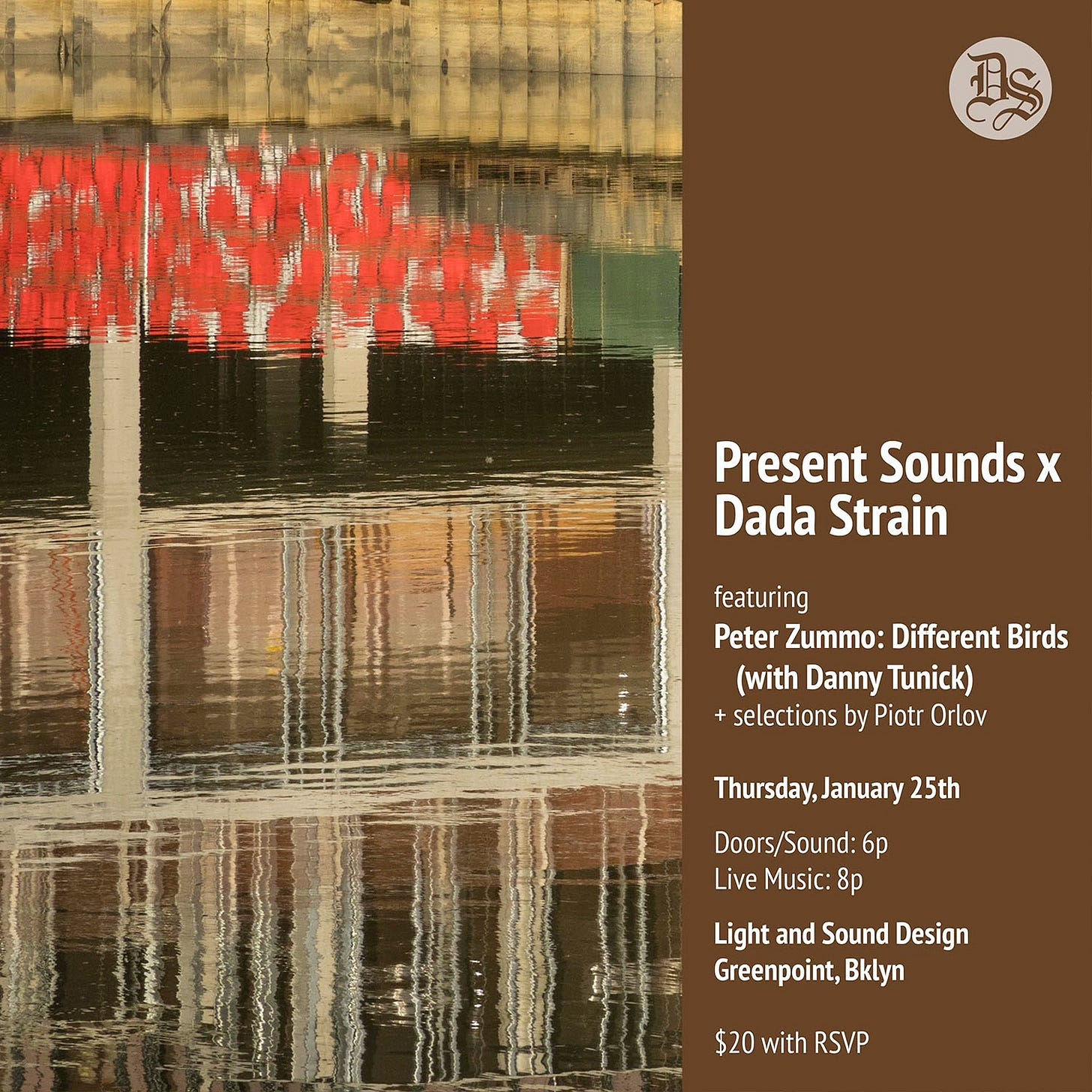Peter Zummo: Different Birds | Bklyn Sounds 1/24/24—1/30/24
Some words from the NYC trombonist playing Thursday's Dada Strain show + Shows: Saint Abdullah & Jason Nazary / Huey Mnemonic / Love Injection / Improv Nights: A Tribute to Derek Bailey / more
On Thursday, January 25th, Dada Strain will present its third live collaboration with Present Sounds, a deep listening series that takes place every week in a private Greenpoint loft. Dada Strain’s contribution to “Present Sounds” features improvised music that engages electronics; and on Thursday, we will present music from Peter Zummo, an artist whose engagement with composition, improvisation and electronic sounds goes to one of this genre-agnostic music’s golden eras, the “Downtown New York” of the 1970s and ‘80s. The brand-new program Zummo will present is called Different Birds, and will also feature drummer/vibraphonist, Danny Tunick.
The 75 year-old trombone player is best recognized from having played on many of Arthur Russell’s great recordings, plus as an early member of John Lurie’s Lounge Lizards and Peter Gordon’s Love of Life Orchestra. Zummo was also a prolific composer and accompanist for many modern dance performances of the era, not least those choreographed and produced by his long-time wife Stephanie Woodard, many of which featured Russell’s amplified cello. (Zummo’s 1985 music for Trisha Brown’s Lateral Pass is especially well-regarded.)
At the time, Zummo was among numerous talented community musicians, constantly collaborating with a group of players all sharing a set of novel ideas about art and sound. Four decades on, the crowd Zummo ran with, is regarded as having been at the forefront of blurring many traditional lines — between composition and improvisation, between high and low art, between levels of participation and observation, between pop, jazz and classical music. Much of the music he recorded during the famed period has only been released over the past decade, as Arthur’s increased notoriety has lifted the boats of his many colleagues.
But of course the details of a life are often more interesting than its broad strokes. Speaking to Peter Zummo after the release of his 2023 album, Deep Drive 2 +, the many layers of a fascinating life sprung forth. For those familiar with the history of New York performance art and music in the latter third of the 20th century, the list of names he cites as teachers, collaborators or inspirations is mind-boggling. And the sounds Zummo continues to record are equally impressive, finding a new sonic space in which to explore the ideas of an era now commonly accepted as legendary, but whose facilitators remain, all-too often, a secret.
I’ve interviewed and spoken with Peter a few times over the years, and in 2023, he and I collaborated on a big interview about his career for Love Injection. The quotes below are from that long conversation he and I had in June. (I urge you to read read the whole conversation in Love Injection issue #69 - thank you to Barbie and Paul for letting me use these quotes.)
On youthful music memories:
One very strong memory I have is that one day the quintet my father was playing with came to our house to rehearse in our living room. The men were so big, the instruments and the sound was so big that it made an impression on me. I was pretty young, less than 10. I liken that experience to going to the train station and seeing a locomotive come in, just so big and loud and impressive. Another [strong memory] is: I was in an all-city orchestra playing trumpet, going downtown to rehearse, and our final concert at the end of that year was held in Severance Hall, which is where the Cleveland Orchestra plays. We did the last movement of Cesar Franck’s “Symphony in D Minor,” and what really stood out to me was that, after we cut off the trumpets and cornets at the end, I heard the reverb of the hall. I was into the reverb in the church the whole time, this natural reverb. I didn't know the word necessarily [at the time], but there was something about the acoustics that I was into. It was pretty much, “That's what I like.”
On embracing the avant-garde:
I came from Cleveland to study physics at Wesleyan and right away, I saw Yasunao Tone do a piece by Takehiro Kosugi. It was a local cellist playing the part of [famed classical cellist] Charlotte Moorman, poised, ready to play with a floodlight projecting a huge fuzzy silhouette on a piece of commercial photography paper that's the whole wall. And Tone on a ladder very carefully cutting out the silhouette [of the cellist], which means moving the ladder, climbing again, moving the ladder, climbing all the way around. And when he finished cutting out the silhouette, he began to eat the paper, and that was the end of the performance. And my reaction was, “All right, I get it.” So that kind of thing was happening. Then I took Alvin Lucier’s first electronic music course, he was coming down (he was the choral director at Brandeis). In Glee Club, we did Robert Ashley's “She Was a Visitor” and I was assigned to the solo speaking part. So all this stuff just started happening. And I thought, “Oh, this is more interesting than physics.”
On becoming a composer:
I didn't realize [I was composing] at first. After graduation, I was based in the Hartford area. Stephanie's friends Wendy Perrin and Risa Jaroslow, who were both part of the experimental dance in downtown New York, were teaching at Trinity College in Hartford. So I was attending the dance concerts. And one night featured [dancer] Steve Paxton with [vocalist] David Moss. I was introduced to Phil Niblock that night, and I said, “Oh, are you a musician?” And he said, “No, I'm a composer.” I almost fell flat on the floor. I didn't know there were composers who were alive. That interested me.
On composing for Downtown dance choreographers:
Stephanie and Wendy Perrin did a piece, “Art on the Beach,” that I did music for. It was on 11 acres of landfill that became Battery Park City, made up of this very strange metallic sand that seemed like it came from another planet. Creative Time was the organization that got its hands into unused real estate and made things happen. They had all the dancers, ranging far and wide, and there was a rise, a kind of a dune that went up a level. I found 4x8 pieces of plywood, one of which was curved, warped. So I built an amphitheater on top of the rise. The group was Arthur Russell, Bill Ruyle playing floor toms and Marc Ribot who had just gotten some new pedal that had some interesting harmonization. And I wrote this minimalist, extended score that goes on for an hour and a half. Trisha Brown went to that. She called me and said, “What you did was so perfect for the dance and the space. Would you write music for me? That's when we started.
On recent projects:
I just recorded in Toronto. Well, I made two recordings. I did this Rewire festival in The Hague, where I was curated into a relationship with a Japanese duo called Kakuhan. One guy named Hino does electronic beats, and the other is Yuki, a cellist, with a huge amount of [effects] processing. It was pretty cool. As I said to [a person] at the record label, “I'm going to act as if I'm post-producing. I don't mind if someone else does or whatever. But that's how I'm going to go into these projects. So we had the live performance, and then we had two days in a pretty cool studio in a tool shed somewhere in Holland. So I wrote music, which I played. And I got into the spoken word thing more, and some singing. That is one thing. In Toronto, it was an eight-piece band — actually, nine at one point — a 90 minute show recorded and then a day in the studio.
I jumped at the chance to play with Tape Hiss [ed. a quintet Zummo plays in with Sonic Youth drummer Steve Shelley, Modern Lovers bassist Ernie Brooks, plus guitarists David Nagler and Pete Galub doing classic ‘70s/’80s downtown/minimal/post-punk repertoire]. But it's weird because I'm just not doing as much presenting of my own live stuff around New York. I'm working, I'm making records, but I tend to go to some other country, putting something together with musicians quickly, presenting it and recording it.
On Arthur Russell:
Arthur went to hip-hop studios in the very beginning, came back to me and said, “This is the music of the future.” And I thought, “You're crazy.” He was right.
For much more of this interview with Peter Zummo (it’s over 5000 words long), visit issue #69 of Love Injection. (Present Sounds x Dada Strain pres. Peter Zummo: Different Birds, with Danny Tunick + selections by Piotr Orlov, Thursday, January 25th, 6p (live music at 8p) @ secret Greenpoint Loft (RSVP for exact location) - RSVP/$20)
This Week’s Shows:
The Lester St. Louis- and Luke Stewart-curated monthly of improvised and electronic music, Assembly, has a great 13th edition. The evening will be helmed by the insightful synths+drums collaboration between Saint Abdullah (the brothers Mohammad and Mehdi Mehrabani-Yeganeh) & Jason Nazary — their live set at Public Records in November was an organic, classic-WARP-Records-on-some-jazz-sh*t session. The evening will also include ETERNITIES (a duo of bass clarinetist Katie Porter and sound artist Bob Bellerue), and guitarist Drew Wesley. Piotr Dada Strain (that’s me) will DJ before, between and after. Come by, it should be heady fun. (Wed 1/24, 8p @ Sisters, Clinton Hill - $20)
Keep reading with a 7-day free trial
Subscribe to Dada Strain to keep reading this post and get 7 days of free access to the full post archives.




